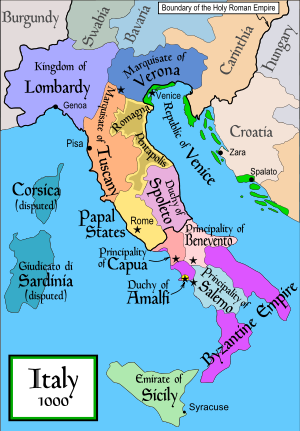- March of Verona
-
The March of Verona and Aquileia was a vast march (frontier district) in northeastern Italy during the Middle Ages, centered on the cities of Verona and Aquileia. Except for Venice, it included the territories of the modern-day regions of Veneto and Friuli-Venezia Giulia as well as Istria and Trentino up to the Adige river. The March of Verona was a strategically important province, which governed the southern approaches to the Alpine passes to Rhaetia.
Contents
History
The Marca Veronensis et Aquileiensis was created by King Berengar I of Italy about 890 as part of a general restructuring of his realm, when it replaced the former Carolingian March of Friuli last held by Berengar's liensman Walfred. It was separated from the Italian kingdom after the German king Otto I had campaigned against King Berengar II of Italy in 951. At the Reichstag meeting at Augsburg in the next year, Berengar II retained Italy, but had to renounce the Veronese march, which was attached to the stem duchy of Bavaria under Otto's brother Duke Henry I. At that time the March of Istria was attached to Verona as a county. From 952 to 975, both Carinthia and Verona were under the control of the dukes of Bavaria, forming a massive Italian, German, and Slavic fief ruled by relatives of the Saxon Ottonian dynasty.[1]
In 976 Emperor Otto II deposed his cousin Duke Henry II of Bavaria and established the Duchy of Carinthia on his southeastern territories, whereafter Verona became a Carinthian march under the Luitpolding duke Henry III the Younger. At various times, the March of Verona was under the control of the Duchy of Carinthia and at other times not. In 975, a commune was chartered in the city, when Otto II ceded to Verona the powers of the marquisate. From this time the city of Verona and other cities in the march developed into independent communes, and the title Margrave of Verona became an essentially empty hereditary honour in the houses of the dukes of Bavaria and Carinthia. Henceforth the Holy Roman Emperors began to appoint vicars to represent them, instead of margraves, in Verona.
From 1004 on several territories in the northwest were allotted to the Imperial Bishopric of Trent by Emperor Henry II the Saint, whose successor Conrad II gave the comital authority in the old County of Trent to the bishops in 1027. In 1061 Dowager Empress Agnes of Poitou enfeoffed the Swabian count Berthold from the House of Zähringen with Carinthia and Verona. Though he could not prevail, neither as Carinthian duke nor as Veronese margrave, he bequested the margravial title to his desendants from the House of Baden. At that time in 1070, Istria was resurrected into a margraviate again and detached from Verona, while in the course of the Investiture Controversy in 1077 the territories of Friuli in the east, with the patriarchal city of Aquileia were separated from the March to provide an ecclesiastical principality of the Patriarch of Aquileia, a direct vassal of King Henry IV.
In 1151 King Conrad III of Germany finally divested Duke Henry V of Carinthia of the Veronese march and enfeoffed Margrave Herman III of Baden. However in 1164, the most important cities formed the Veronese League, a Städtebund aimed at protecting their independence against the Italian policies of Emperor Frederick Barbarossa. The League was led by Venice; other members were Verona, Padua, Vicenza, and Treviso. In 1167, the Veronese League joined the Lombard League; this constituted the de facto end of the march, confirmed by the Lombard victory at the 1176 Battle of Legnano. The Holy Roman Emperors continued to name vicars into the fifteenth century, though by then the office was purely nominal, as most of the territory of the march was held as terra ferma by the Republic of Venice.
Margraves
Dukes of Bavaria
Dukes of Carinthia
- 976 – 978 Henry III the Younger, deposed
- 978 – 985 Otto I
- 985 – 989 Henry III the Younger, again
- 989 – 995 Henry II the Wrangler, again
- 995 – 1004 Otto I, again
- 1004 – 1011 Conrad I
- 1011 – 1035 Adalbero of Eppenstein
- 1035 – 1039 Conrad II, son of Conrad I
- 1047 – 1055 Welf
- 1056 – 1061 Conrad III
- 1061 – 1077 Berthold I
- 1077 – 1090 Liutold of Eppenstein
- 1090 – 1122 Henry IV
- 1122 – 1123 Henry V
- 1123 – 1135 Engelbert
- 1135 – 1144 Ulrich I
- 1144 – 1151 Henry VI
House of Baden (titular)
- 1061 – 1073 Herman I, son of Berthold I
- 1112 – 1130 Herman II, son of Herman I
- 1151 – 1160 Herman III, son
- 1160 – 1190 Herman IV, son
- 1190 – 1243 Herman V, son
- 1243 – 1250 Herman VI, son of Herman V
- 1250 – 1268 Frederick I, son, beheaded
Notes
Sources
 This article incorporates text from a publication now in the public domain: Chisholm, Hugh, ed (1911). Encyclopædia Britannica (11th ed.). Cambridge University Press.
This article incorporates text from a publication now in the public domain: Chisholm, Hugh, ed (1911). Encyclopædia Britannica (11th ed.). Cambridge University Press.
Categories:- Lists of office-holders
- Medieval Italy
- States of the Holy Roman Empire
- Former countries on the Italian Peninsula
Wikimedia Foundation. 2010.

